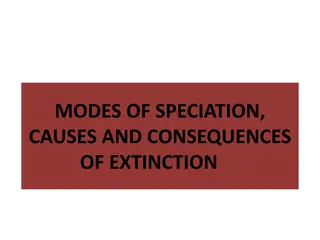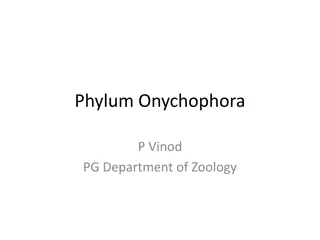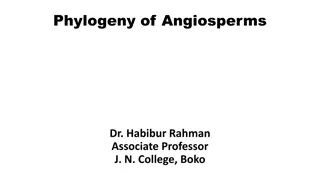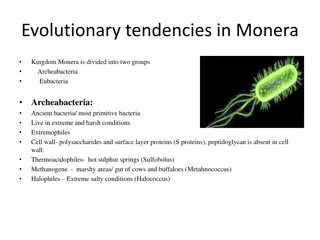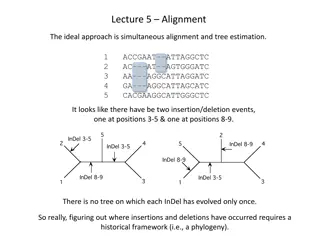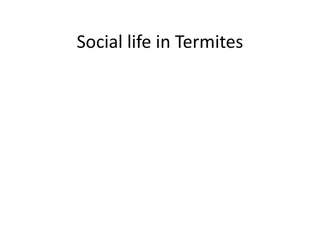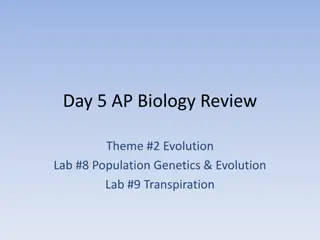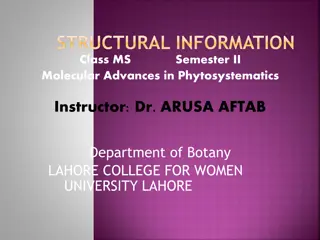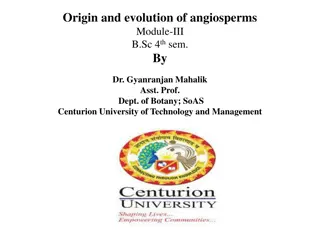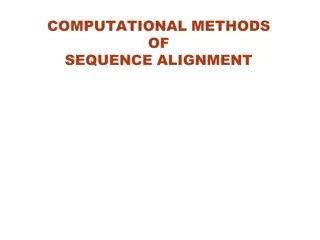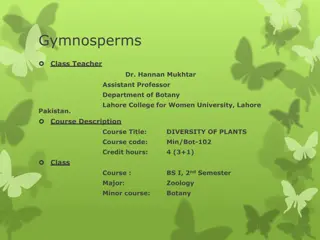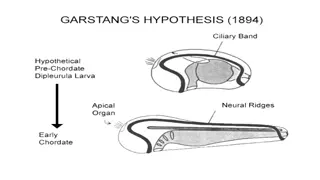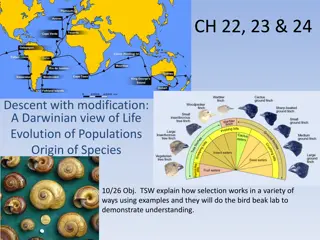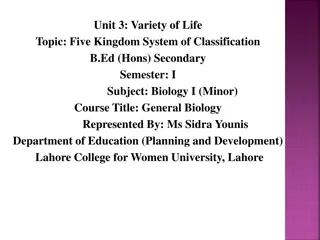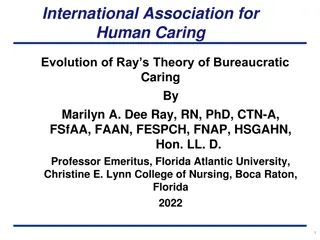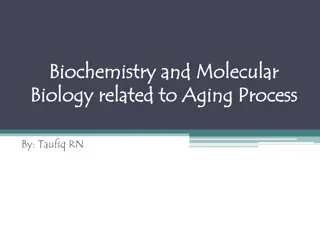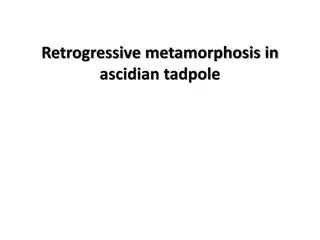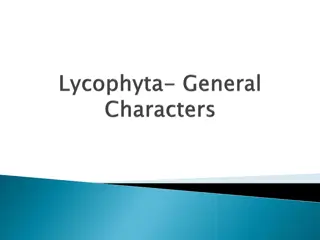Evolutionary Insights of Basidiomycota Dikaryons
Basidiomycota, a successful fungal group with 30,000 known species, predominantly exhibits filamentous vegetative growth while also producing yeast forms. The multi-layered cell wall and regularly septate hyphae with dikaryotic mycelium are key characteristics. Recent experimentation on Schizophyllum commune dikaryons unveiled insights into adaptation dynamics in response to natural selection over 13,000 generations. The study revealed coadaptation between nuclei, genetic exchange, and recombination, shedding light on the evolutionary consequences of being a basidiomycetous dikaryon.
Download Presentation

Please find below an Image/Link to download the presentation.
The content on the website is provided AS IS for your information and personal use only. It may not be sold, licensed, or shared on other websites without obtaining consent from the author. Download presentation by click this link. If you encounter any issues during the download, it is possible that the publisher has removed the file from their server.
E N D
Presentation Transcript
Basidiomycota - Major characteristics - Major evolutionary groups
Basidiomycota: major characteristics - Very successful group; approx. 30,000 known species out of the ca. 75,000 known - Vegetative growth: ---- mostly filamentous, but yeast forms are also produced; ---- hyphal cords (including rhizomorphs) and sclerotia not uncommon; ---- asexual reproduction from chlamydospores or arthrospores can occur (no conidiospores!). - Cell wall: ---- multi-layered (EM observation); (two-layered in the Ascomycetes);
Basidiomycota: major characteristics - Very successful group; approx. 30,000 known species out of the ca. 75,000 known - Vegetative growth: ---- mostly filamentous, but yeast forms are also produced; ---- hyphal cords (including rhizomorphs) and sclerotia not uncommon; ---- asexual reproduction from chlamydospores or arthrospores can occur (no conidiospores!). - Cell wall: ---- multi-layered (EM observation); (two-layered in the Ascomycetes); - Mycelium: ---- Regularly septate hyphae: -------- dolipore with parenthesome: (typical of Basidiomycota, see L1); -------- or simple septate with occlusion (e.g., smuts and rusts) ---- clamp connections often present; ---- dikaryotic;
Experimentation, and reflections on evolutionary consequences of being a basidiomycetous dikaryon. Travis A. Clark, T.A & J.B. Anderson. 2004. Dikaryons of the Basidiomycete Fungus Schizophyllum commune: Evolution in Long-Term Culture. Genetics 167: 1663 1675 ABSTRACT The impact of ploidy on adaptation is a central issue in evolutionary biology. While many eukaryotic organisms exist as diploids, with two sets of gametic genomes residing in the same nucleus, most basidiomycete fungi exist as dikaryons in which the two genomes exist in separate nuclei that are physically paired and that divide in a coordinated manner during hyphal extension. To determine if haploid monokaryotic and dikaryotic mycelia adapt to novel environments under natural selection, we serially transferred replicate populations of each ploidy state on minimal medium for 18 months (ca. 13,000 generations). Dikaryotic mycelia responded to selection with increases in growth rate, while haploid monokaryotic mycelia did not. To determine if the haploid components of the dikaryon adapt reciprocally to one another s presence over time, we recovered the intact haploid components of dikaryotic mycelia at different time points (without meiosis) and mated them with nuclei of different evolutionary histories. We found evidence for coadaptation between nuclei in one dikaryotic line, in which a dominant deleterious mutation in one nucleus was followed by a compensatory mutation in the other nucleus; the mutant nuclei that evolved together had the best overall fitness. In other lines, nuclei had equal or higher fitness when paired with nuclei of other histories, indicating a heterozygote advantage. To determine if genetic exchange occurs between the two nuclei of a dikaryon, we developed a 24-locus genotyping system based on single nucleotide polymorphisms to monitor somatic exchange. We observed genetic exchange and recombination between the nuclei of several different dikaryons, resulting in genotypic variation in these mitotic cell lineages.
Basidiomycota: major characteristics - Reproductive structures: --- many species form large basidiomata (= basidiocarps, fructifications, or fruiting bodies; e.g., mushrooms) ====> includes the bulk of the edible fungal species; --- some taxa (e.g., rusts and smuts) do not produce basidiomata.
Basidiomycota: major characteristics - Reproductive structures: --- many species form large basidiomata (= basidiocarps, fructifications, or fruiting bodies; e.g., mushrooms) ====> includes the bulk of the edible fungal species; --- some taxa (e.g., rusts and smuts) do not produce basidiomata. - Three major ecological roles: --- saprobic: (=decomposer of organic matter), -------- e.g. white-rot (= lignin-degrading) and brown-rot of wood; ====> Carbon cycling; --- symbiotic: -------- with plants: mycorrhiza (mostly ecto-) with trees and shrubs, sometimes with grassy plants e.g. orchids; -------- with insects: fungal gardens of ants and termites; scale insects; -------- with algae: a few basidiolichens exist. --- parasites / pathogenic: -------- mostly on plants (e.g., rusts and smuts); -------- also in animals including humans (e.g., Cryptococcus)
The basidium (plural = basidia) - definitions Basidiospores: sexual spores (result of karyogamy and meiosis). Basidium: structure bearing basidiospores on its surface; --- probasidium - site of karyogamy --- metabasidium - site of meiosis Holobasidium: a non-septate basidium; single-celled, typically club-shaped, and bearing sterigmata (usually four) --- chiastobasidium: a holobasidium in which, during meioisis, the nuclear spindles / microtubules are oriented perpendicular to the long axis of the basidium, and at the same level. --- stichobasidium: during meiosis the nuclear spindles / microtubules are oriented parallel to the long axis of the basidium (are not at the same level). Heterobasidium: any type of basidium that differ from a typical holobasidium Phragmobasidium: a septate basidium (a phragmobasidium is an heterobasidium) B: Holobasidium; 1-4: basidiospores; Arrows: sterigmata (SEM, from Alexopoulos)
Basidiomycota: types of basidia From Kendrick A: holobasidium; B-F: heterobasidia; C-F: phragmobasidia F: basidia of rusts germinating from a teliospore.
Development of a 4-spored basidium From Kendrick -Basidiospores are haploid, and generally uninucleate; binucleate basidiospores are sometimes formed, when a mitosis follows the meiosis (either in the basidium or in the spore). - 2-spored and 8-spored basidia are sometimes formed (rare).
Life-cycle of an of Basidiomycota meiosis immediately follows karyogamy Formation of a secondary mycelium (dikaryon / heterokaryon) -- generally the longest living stage arthrospore Binucleate basidiospores in this example (basidiospores are generally unicleate) Fusion between two primary mycelia (somatogamy) Basidiospore germination ==> Primary mycelium (haploid nuclei / homokaryon) arthrospores FromClemen on Formation of arthrospores or chlamydospores is possible for asexual reproduction /genet dssemination
Sexual Reproduction in Basidiomycota Two steps: (1) hyphal fusion and exchange of nuclei (somatogamy via anastomosis, and nuclear migration) (2) nuclear fusion (karyogamy) and meiosis Homothallic: a single strain can undertake sexual reproduction (self-compatibility) --Advantages?Disadvantages? -- strictly homothallic species do not have a mating type system. Heterothallic: two different but genetically compatible strains undergo sexual reproduction; -- The majority of Basidiomycota species are heterothallic.
Sexual Reproduction in Basidiomycota Two steps: (1) hyphal fusion and exchange of nuclei (somatogamy via anastomosis, and nuclear migration) (2) nuclear fusion (karyogamy) and meiosis Homothallic: a single strain can undertake sexual reproduction (self-compatibility) --Advantages?Disadvantages? -- strictly homothallic species do not have a mating type system. Heterothallic: two different but genetically compatible strains undergo sexual reproduction; -- The majority of Basidiomycota species are heterothallic. Mating systems of heterothallic species are either unifactorial (bipolar), or bifactorial (tetrapolar) -- In Basidiomycota, ~25% of heterothallic species are unifactorial; ~75% are bifactorial Unifactorial (bipolar) matingtype: -- one locus (= factor) controls the mating; -- different alleles at that locus are required for compatibility of nuclei; -----A Basidiomycota species can have from a few to several hundred alleles at the mating type locus; -----A1 X A2 (karyogamy) ===> A1A2 (meiosis) ===> A1 + A2 (spores) ===> 50% incompatibility (compatibility) in sibling pairing of spores (sibling pairing = pairing of spores from the same basidiocarp progeny)
Sexual Reproduction in Basidiomycota Bifactorial (tetrapolar) mating type: -- two loci (= factors) control the mating (they are typically labeled A and B factors); these two loci are generally located on different chromosomes. -- different alleles required at both loci for mating compatibility; ---- Numerous alleles per locus exist within a specie; ----A1B1 X A2B2 (karyogamy) ===> A1B1A2B2 (meiosis) ====> A1B1, A2B2 (if no crossingover), or A1B1, A2B2, A1B2, A2B1 if crossingover. ===> 75% incompatibility or 25% compatibility in sibling pairing of spores
Sexual Reproduction in Basidiomycota Bifactorial (tetrapolar) mating type: -- two loci (= factors) control the mating (they are typically labeled A and B factors); these two loci are generally located on different chromosomes. -- different alleles required at both loci for mating compatibility; ---- Numerous alleles per locus exist within a specie; ----A1B1 X A2B2 (karyogamy) ===> A1B1A2B2 (meiosis) ====> A1B1, A2B2 (if no crossingover), or A1B1, A2B2, A1B2, A2B1 if crossingover. ===> 75% incompatibility or 25% compatibility in sibling pairing of spores Function of A & B alleles discerned via partial compatibility crosses: ex. in Schizophullum commune (Raper, 1966) - cross between A1B1 X A1B2 (identical A alleles) ===> no clamp connections observed: somatic incompatibility - fusion between A1B1 X A2B1 (identical B alleles) ===> clamp connections formed but no migration of nuclei: zygotic (nuclear) incompatibility The realty is slightly more complex than the A/B factorial system proposed by Raper, but in practice that system generally works well to interpret the results of mating compatibility tests on a genetic basis.
UNIFACTORIALMATING SYSTEM Spores from the same progeny (e.g., from the same basidiocarp) carry either the Ai or Aj mating allele (there are n alleles in an interbreeding population / species) Ai Aj Ai - + Within the same progeny, chance of mating is 50% Aj + -
BIFACTORIAL MATING SYSTEM Spores from the same progeny (e.g., from a same basidiocarp) carry either the Ai-By or Aj-Bx mating alleles. Within the same progeny, chance of: AiBy AjBy AiBx AjBx AiBy - ~ - + + successful mating is 25% AjBy - + - ~ partial compatibility (i.e., somatic fusion possible but no nuclear migration / karyogamy) is 25% AiBx - ~ AjBx - - complete incompatibility is 50%
How to conduct a mating compatibility experiment - Example from the agarics strain 1 strain 2 Prepare single spore isolates (= monokayons, which don t have clamp connections) on agar Conduct intra-strain crosses to determine the strain s mating type (i.e, uni- or bifactorial); identify and isolate all possible allelic type (2 if uni-, and 4 if bifactorial) Conduct inter-strain crosses in all possible pairwise combinations of the identified allelic types of each strain
Basidiomycota: major evolutionary groups Agaricomycotina Macrofungi(mostly) Ustilaginomycotina smuts Pucciniomycotina rusts 18S and 25S nuc rDNA phylogeny Lutzoni et al., 2004) Classification in Hibbett et al., 2007
Basidiomycota: major evolutionary groups (ca. 11,000 knownspp.) - - - dolipore septum basidiomata holobasidia (ca. 3,000 known spp.) - - het erobasidia ( including phragmo-) - dolipore or simple pore septum basidiomata (ca. 1,200 known spp.) - t eliospores inst ead of basidiomata - teliospores terminal - phragmobasidia - simple pore septum (ca. 5,000 known spp.) - t eliospores inste ad of basidiomata - te liospore mostly - phragmobasidia - simple pore sept um intercalary Urediniomycetes and Ustilaginomycetes are characterized by the formation of teliospores, which directly produce phragmobasidia and basidiospores (more later) ; they fungi are also referred as Teliomycetes.
Classification of Basidiomycota Hibbett et al. 2007





